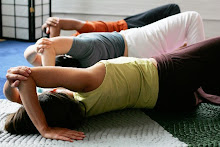
Get a bunch of people together, and there's no telling what they'll say.
Yesterday, the people ranged in age from 17 to 80: a student, an engineer, an accountant, two musicians, a psychotherapist, a jewelry-maker, a photographer/homemaker, some entrepreneurs. They had only two things in common: they knew one of the hosts (I, or my partner, Chris Welsh), and they had just seen the Geopalooza exhibit at the Houston Museum of Natural Science. We gathered back at our home for refreshments and conversation to reflect on what we had experienced. This diverse group of strangers had come together to talk about ROCKS.
Over tapas and sangria, we developed several alternate theories about the West Texas Marfa Lights: the most plausible were the high concentration of crystals in the ground, causing electromagnetic reactions and "ghost lights," or it's college kids with big flashlights and cases of Shiner Bock at their disposal. Several of our guests confessed that they lusted after the huge sheet of copper ore in the display. Business cards were exchanged with the jeweler, who already had design ideas. We talked about panning for gold and cracking geodes, about fossils and trilobytes, about meteorites, discovery, and preservation of priceless objects.
"I kept thinking about those geodes, which are so plain on the outside, but so glorious on the inside," one man spoke. "Some of them were really ugly, and there's no way to tell what beauty is inside until you crack it open and have a look." He continued, "And, a geode is only created when hot, mineral-rich water seeps or flows in through some opening. The crystals form in the spaces, the void within. Perhaps that's a metaphor for us. We need to seek the void."
That's the idea that stuck with me through the rest of the wide-ranging conversation, and it will linger awhile yet. In the era of 24-hour media, it's hard to find a void, any "empty space" for silence, breathing, one's original thoughts, or rest. One can become completely petrified; schedule, ideas, body "set in stone," without possibility for flexibility or opening to allow anything new to come in. The "hot water" we perceive can erode, or transform.
This weekend, a friend asked me to have a look at his frozen shoulder. He's already had the pictures done, and his doctors have said there's no structural cause they can find for his pain. Short story: after about 30 minutes of a Feldenkrais lesson, he was able to move more, with less pain. What happened? I like to think that I showed him where there was some space, where there was room for possibility. We found an opening where he might rediscover a forgotten pathway in his shoulder, or he might find a new pattern for movement. The point is, he can do more of what he wants to do.
Moshe Feldenkrais certainly understood the idea of "hot water," as he was a man who endured difficult times. He also understood that hot water, or anything else, has no inherent goodness or badness: it depends on the use. Leave your broccoli in hot water too long, and you'll have green mush. If you have enough hot water at the right temperature, you can immerse yourself in it and have a delightful experience. Some anxiety creates stress that wears you down. The right kind of anxiety, in the right amounts, leads to creativity, productivity, and positive solutions. Any perturbation of a habitual pattern can be perceived as "hot water."
Feldenkrais based his work on the interplay of the dynamic human being with a dynamic set of conditions, the environment. Humans grow, learn, and evolve in every dimension as they become engaged with possibility. Possibility is the space, the void, where human treasure is discovered.



1 comment:
Thank you so much for sharing your groups experience with Geopalooza - it was really interesting to read about what everyone took away with them from the exhibit. It so cool that you guys all came to see the exhibit and then sat down to talk about it! My favorite part is the fluorescent minerals - they look so plain in regular light, but turn on a black light and they are stunning. It's amazing that someone took the time to figure that out. Thanks again for sharing.
Post a Comment